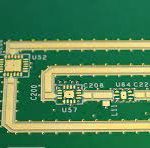How Thin Is Copper on RF PCB?
Copper on RF PCB
Copper is the primary conductor in a PCB, and its thickness is one of the critical factors in current capacity and impedance. Thicker copper, referred to as “heavy copper” in the industry, has higher electrical properties and can handle high-current loads. However, the additional cost of heavier copper can increase the overall price of the board, so designers should take care to design their boards for the optimum balance of performance and manufacturing cost.
1oz copper is the standard thickness for most PCBs, as it offers an ideal balance of capabilities that fit standard fabrication processes and meets most design requirements. This thickness provides good conductivity and durability for most circuits, but is less suitable for higher currents or RF applications. Thicker copper is needed to maintain an acceptable level of signal interference between traces and to handle more substantial power loads without overheating.
The metallurgy of the copper used in a rf pcb can have a significant impact on performance, especially at lower frequencies. The surface of the copper is etched to create the conductive path, and its roughness can contribute to a significant amount of loss in the finished conductor. To minimize this loss, designers should use smooth, uniform traces in their designs and follow best practices for spacing and trace widths.

How Thin Is Copper on RF PCB?
Another important factor in the performance of a PCB is its ability to dissipate heat generated by high-power circuits. The copper layers in a PCB absorb the excess heat and conduct it away through conduction and radiation. To ensure proper thermal management, designers should choose a PCB with thicker copper and ensure that the copper is evenly distributed throughout the layers of the stack-up.
The PCB manufacturing process involves chemical solutions that can affect the quality of the copper, so there is some variation in the thickness of each layer. It is common for the outer layers to have a higher copper weight than the inner layers. However, the best practice is to keep the copper weight of each layer consistent throughout the entire stack-up. This will help to prevent the outer layers from twisting and bowing under the high temperatures required for assembly.
There are many ways to optimize the copper in a PCB, including choosing the right etching recipe and making sure the design is properly aligned with the copper thickness. In addition, it is important to use a tool that enables designers to see the effect of copper thickness and traces on current capacity, impedance, and signal transmission. There are a number of 3rd party tools available for this purpose, and they can help designers make informed decisions about the appropriate copper thickness for their designs. However, the final decision on the PCB design and build should always be made by a professional, qualified designer. By doing so, they can ensure that the final product meets the specifications of their customers and will function reliably for years to come.